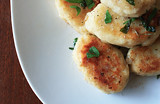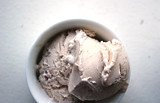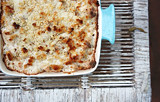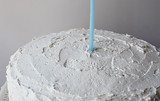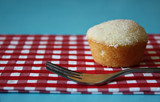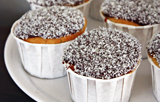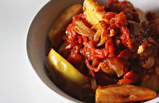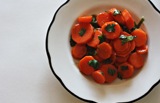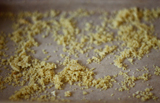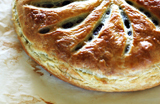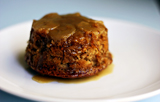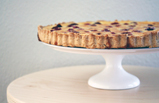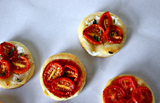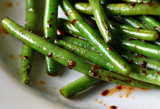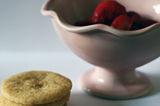skip to main |
skip to sidebar
 Is there such a thing as a light potato salad? Probably not. Potato is one of the earth's heavier substances, and that's as it should be. But when the weather warms and you're baking pork chops and you want a little something on the side, but the thought of mayonnaise or sour cream is too daunting, may I present this solution: a potato salad that's creamy with mustard and bright with parsley.
Is there such a thing as a light potato salad? Probably not. Potato is one of the earth's heavier substances, and that's as it should be. But when the weather warms and you're baking pork chops and you want a little something on the side, but the thought of mayonnaise or sour cream is too daunting, may I present this solution: a potato salad that's creamy with mustard and bright with parsley.
The dressing is loosely borrowed from a bean salad in Simon Hopkinson's Week In, Week Out, a compilation of 52 of his weekly food columns for The Independent. I love the way Hopkinson writes and cooks. He's unapologetically irritable - sort of the Simon Cowell of UK food writers. But he's also generous, passionate, perfectionist, uncompromising; and his food is so good.
I haven't specified the amount of potato - the recipe makes plenty of dressing, more than I needed for the pound of potatoes I cooked, so there's room for maneuver.
Creamy Mustard Potato Salad
small waxy-skinned potatoes (I used red Yukons)
1 tbsp smooth Dijon mustard
1 tbsp red wine vinegar
1/2 clove garlic, peeled and crushed
4 tbsp warm water
150 ml peanut oil
150ml extra virgin olive oil
salt & pepper1 red onion, diced very fine
a handful of parsley
Peel the potatoes and place in a saucepan with plenty of water. Bring to the boil; add a dash of salt once boiling. From this point, cook the potatoes for 10-15 minutes, or until just tender. Drain.
While the potatoes are cooking, combine the mustard, red wine vinegar, garlic and warm water. Blend or whisk until smooth. Slowly add the oils and blend/whisk well until the dressing is creamy. Season with salt and pepper to taste.
Fry the finely diced red onion in a little hot butter or oil for 3 or 4 minutes (if you like raw onion, feel free to omit this step).
Carefully cut the cooked potatoes into small chunks - whichever size you prefer, really. Toss with the dressing, the red onion, and a handful of parsley leaves, some chopped and some left whole. Add more salt and pepper if necessary.
This dressing is also delicious drizzled over barely-blanched green beans.
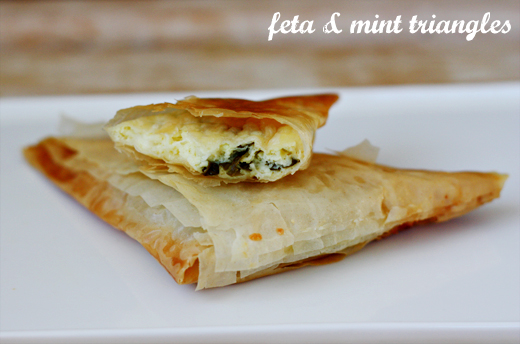 I'm envious and admiring today of people with houses and gardens and vegetable patches; of the pleasure they must feel at this time of the Northern Hemisphere year, when just three days of bright, hot weather can make all the difference to their sprouts and seedlings. Suddenly, we have blossoms and magnolias, buds on the barest of winter trees, and birds singing late into the evening. This tangible sense of the world's turning still astonishes my sub-tropical soul. It also makes sense of a great deal of poetry.
I'm envious and admiring today of people with houses and gardens and vegetable patches; of the pleasure they must feel at this time of the Northern Hemisphere year, when just three days of bright, hot weather can make all the difference to their sprouts and seedlings. Suddenly, we have blossoms and magnolias, buds on the barest of winter trees, and birds singing late into the evening. This tangible sense of the world's turning still astonishes my sub-tropical soul. It also makes sense of a great deal of poetry.
These crisp filo pastries filled with tart feta cheese and bursts of mint are just right for eating out of doors with a green salad and a glass of white wine some sweet, late-April evening - like this one. Take the sheets of filo pastry out of the refrigerator only when you're ready to use them (they dry out quickly). Work with the pastry as fast as you can for the same reason. Brushing with the melted butter will soften areas that have hardened, and don't worry too much about neatness.
Take the sheets of filo pastry out of the refrigerator only when you're ready to use them (they dry out quickly). Work with the pastry as fast as you can for the same reason. Brushing with the melted butter will soften areas that have hardened, and don't worry too much about neatness.
It's also quite difficult to explain in words how to form the triangles themselves. I've included some photographs of the process, but the need to work quickly so the filo won't tear made that difficult. It's much easier and more intuitive than it looks; once you're in the thick of things, the next step will feel obvious.
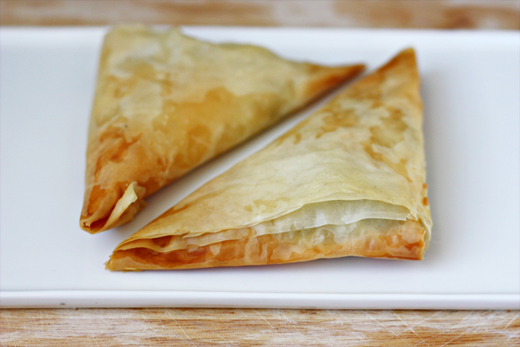 Feta & Mint Triangles
Feta & Mint Triangles
adapted from Claudia Roden, Arabesque (US, UK)
7 oz feta cheese, mashed with a fork
1 egg, lightly beaten
3 tbsp chopped mint
1 tsp freshly squeezed lemon juice
salt & pepper
8 large sheets filo
1 stick (8 tbsp) butter, melted (yes, this feels like a lot of butter, and I didn't use it all. You might want to begin with half a stick and gauge what more you think you might need.)
To make the filling, mash the feta cheese with the egg, chopped mint and lemon juice. Season with a little salt and pepper.
Preheat the oven to 300° Fahrenheit / 150° Celsius.
Just before you're ready to use them, cut the sheets of pastry into four rectangles measuring about 12 inches x 4.5 inches and put them in a pile on top of each other. Brush the top piece of pastry thoroughly with melted butter.
Take about a tablespoon of filling and place it in the upper right hand corner of the top sheet of pastry. Fold this upper right hand corner across the filling in order to form a triangle, leaving about a 1 cm strip of pastry free (see photographs below).
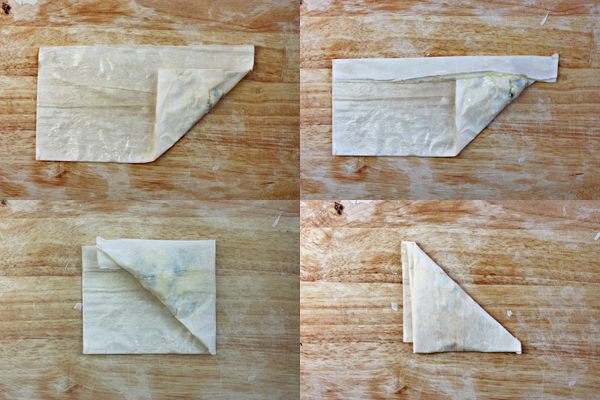 Fold this free strip of pastry over the edge of the triangle, brushing with butter and tucking the excess at the very top underneath. Now you should have a folded triangle of cheese-filled pastry with about 2/3 of the filo rectangle still visible. Brush with more butter and then lift the highest tip of the triangle and fold it down over the pastry once; brush again with butter, and fold again until you have a neat triangle shape. There should be a little excess pastry, which you can neaten by brushing with butter and folding over the edge of the triangle.
Fold this free strip of pastry over the edge of the triangle, brushing with butter and tucking the excess at the very top underneath. Now you should have a folded triangle of cheese-filled pastry with about 2/3 of the filo rectangle still visible. Brush with more butter and then lift the highest tip of the triangle and fold it down over the pastry once; brush again with butter, and fold again until you have a neat triangle shape. There should be a little excess pastry, which you can neaten by brushing with butter and folding over the edge of the triangle.
Do the same with the remaining strips of pastry and cheese filling. Place the triangles, seam side down, on a baking sheet and brush the tops with melted butter. Bake for 30 minutes or until golden. Serve warm.
 On April 25, 1915, Allied forces invaded Turkey, which had entered WWI on the side of Germany: this was the Gallipoli Campaign. The campaign failed, resulting in incredible losses on both sides. Many of the men who died were ANZACs - members of the Australian and New Zealand Army Corps (other casualties included Canadians, Dubliners, and almost the entire male population of a small Lancashire town). April 25 - ANZAC Day - is commemorated with an almost sacred reverence in Australia and New Zealand. It's a public holiday (Remembrance Day is not). There are dawn services, parades through cities, and the brief, one-day-of-the-year legality of a gambling game called 'two-up'. There are also ANZAC biscuits: rolled oat cookies spiked with coconut and the caramel sweetness of golden syrup. They're very loosely based on the biscuits that were sent to ANZAC troops during the war, out of Arnott's Biscuits' massive commercial ovens: hard, dry, long-life substitutes for bread.
On April 25, 1915, Allied forces invaded Turkey, which had entered WWI on the side of Germany: this was the Gallipoli Campaign. The campaign failed, resulting in incredible losses on both sides. Many of the men who died were ANZACs - members of the Australian and New Zealand Army Corps (other casualties included Canadians, Dubliners, and almost the entire male population of a small Lancashire town). April 25 - ANZAC Day - is commemorated with an almost sacred reverence in Australia and New Zealand. It's a public holiday (Remembrance Day is not). There are dawn services, parades through cities, and the brief, one-day-of-the-year legality of a gambling game called 'two-up'. There are also ANZAC biscuits: rolled oat cookies spiked with coconut and the caramel sweetness of golden syrup. They're very loosely based on the biscuits that were sent to ANZAC troops during the war, out of Arnott's Biscuits' massive commercial ovens: hard, dry, long-life substitutes for bread.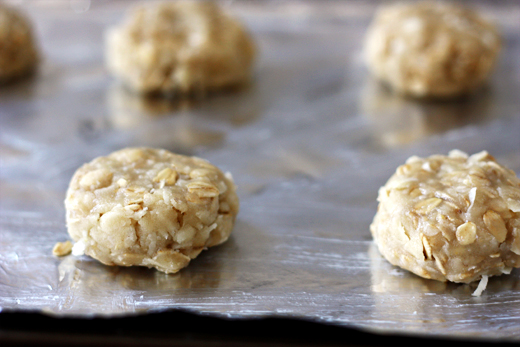 The original ANZAC biscuits looked nothing like the ones I cooked this morning - no one was baking with butter like this in 1915. The recipe on the Australian War Memorial website includes plain and wholemeal flours, sugar, milk powder, a pinch of salt and some water to bind it all together. Today's recipes are still eggless, but they're sweet and soft. Instead of a hard wartime biscuit (soldiers on the front used to grind them up into a porridge), ANZAC biscuits are chewy with rolled oats and nutty with coconut. I love them this way, with a little bite to them. If you prefer yours crunchy, bake them for about 5 minutes more than the given time - but be careful, they burn quickly.
The original ANZAC biscuits looked nothing like the ones I cooked this morning - no one was baking with butter like this in 1915. The recipe on the Australian War Memorial website includes plain and wholemeal flours, sugar, milk powder, a pinch of salt and some water to bind it all together. Today's recipes are still eggless, but they're sweet and soft. Instead of a hard wartime biscuit (soldiers on the front used to grind them up into a porridge), ANZAC biscuits are chewy with rolled oats and nutty with coconut. I love them this way, with a little bite to them. If you prefer yours crunchy, bake them for about 5 minutes more than the given time - but be careful, they burn quickly.
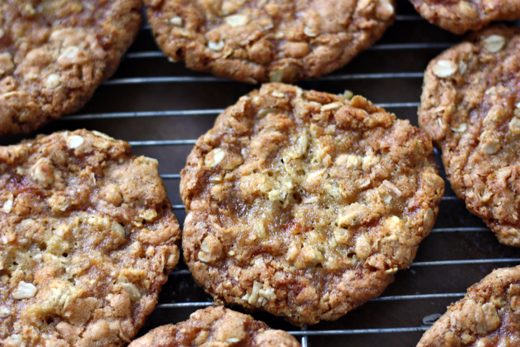
ANZAC Biscuits
From a recipe provided by a veteran of the Gallipoli landings, found here.
1 cup plain flour
1 cup sugar
1 cup rolled oats
1 cup desiccated coconut
4 oz (1 stick) butter
1 tbsp golden syrup
2 tbsp boiling water
1 tsp bicarbonate of soda (baking soda)
Preheat oven to 180°C / 375°F.
Grease a cookie sheet very well (these babies stick), or line with baking paper. Combine the dry ingredients in a large bowl. Combine the butter and golden syrup in a small saucepan and place over a low heat until the butter has melted. Combine the boiling water and bicarbonate of soda, stirring until there are no lumps, and then add to the melted butter mixture. Pour these combined liquids into the dry ingredients and mix thoroughly. If the mixture seems too dry to form into balls, add more hot water.
Form mixture into small balls of about 1 teaspoonful and place on the greased baking tray. The biscuits spread a great deal while baking, so place them far apart - depending on the size of your tray, you may need to cook them in two batches.
Bake for 12 minutes, until golden. Allow to cool on the tray before removing them to a cooling rack - they'll be too soft when they first come out of the oven, but will soon harden.
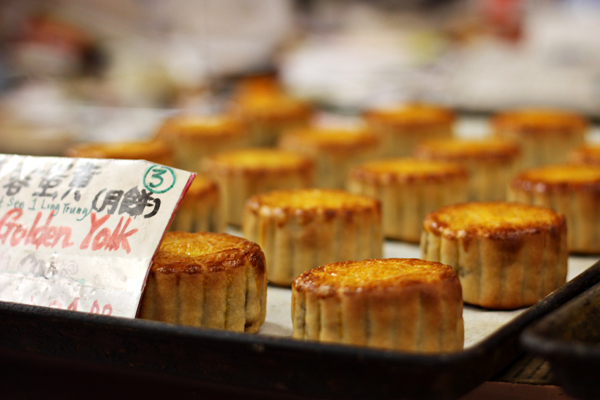 Chinatown, San FranciscoI've been home from my 2 weeks in Texas, California and Mexico for a week now, and I've finally made it through my photos and unpacked my bags. It's been an especially long transition back to normal life, and for the very best of reasons - I had such a wonderful time. Every one of these places was new to me. I now have a huge crush on California, am completely in love with Mexico, and am happy to say that I liked Austin, TX so much I'll be moving there in August.
Chinatown, San FranciscoI've been home from my 2 weeks in Texas, California and Mexico for a week now, and I've finally made it through my photos and unpacked my bags. It's been an especially long transition back to normal life, and for the very best of reasons - I had such a wonderful time. Every one of these places was new to me. I now have a huge crush on California, am completely in love with Mexico, and am happy to say that I liked Austin, TX so much I'll be moving there in August.
Much of the trip wasn't particularly food-heavy - it was on-the-road kind of food, stopping where we could when we could, depending on what was around (good hearty breakfasts at tiny Buck Meadows outside Yosemite National Park, for example), but some meals really stood out (and of course, once we hit Mexico, everything was amazing).
I was in Austin only briefly, but ate a spectacular tomatillo pork burrito at:
El Chilito
2219 Manor Drive
Austin, Texas 78722
+1 512 382 3797
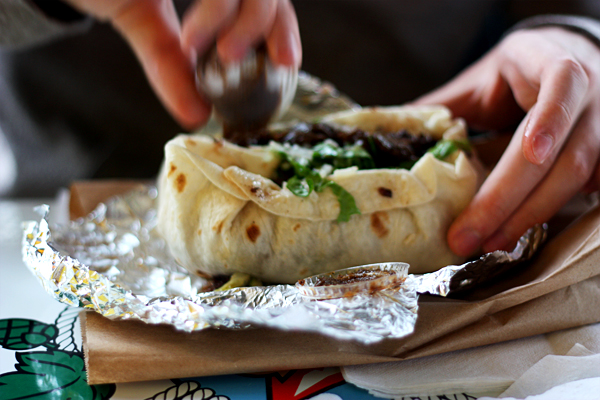
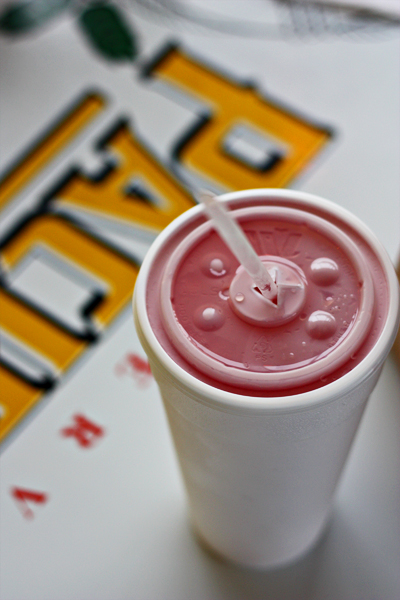
The highlight in California was my pulled pork sandwich and potato salad at:
Bounty Hunter Wine Bar & BBQ
975 First Street
Napa, California 94559
+1 707 226 3976
(And it was fascinating to see the table set for dinner at Hearst Castle, San Simeon, complete with paper napkins - embossed with WRH, of course - and ketchup in bottles.)

During our day and a half in Mexico City we ate from small taco bars, where they fried up thin strips of beef alongside your tortilla and served it all topped with raw onion, wedges of avocado and tomato, and squeezes of lime; or cheap and cheerful rotisserie chicken places, where the juicy joints came with fried potatoes, onions, red salsa and pickles.
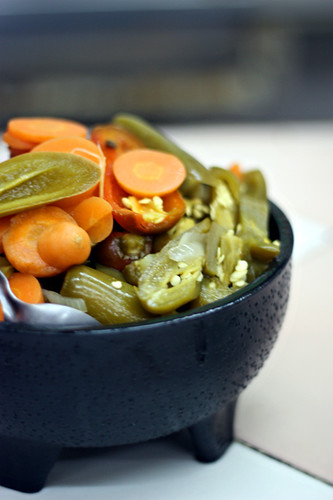


The sweets and pastries were incredible, and I liked these 2 patisseries in particular:
Dulceria de Celaya
Avenida Cinco de Mayo 39
Colonia Centro
Mexico City
+52 55 55211787
Panificadora La Vasconia
Calle Tacuba 73
Colonia Centro
Mexico City
+52 55 210659



We spent nearly a week in Puebla, a beautiful and lively colonial city on the road between Mexico City and Oaxaca. The bus from Mexico City takes about two hours and passes between Popocatépetl and Iztaccíhuatl, Mexico's most famous volcanoes. Besides a fabulous wedding and the fascinating Good Friday procession through the streets of Puebla (Easter is a wonderful time to be in Mexico), we ate very well. I can't document all the little gordita stands we snacked at, or tell you the name of the purveyors of handmade tres leches ice cream who waited, with their wares in big tubs of salted water, at the foot of the Aztec pyramid in the small town of Cholula, but I can recommend these two restaurants in particular:
For Mexican fusion (I ate a smoked cheese risotto, duck confit chalupas, stuffed poblano chiles and an amaranth mousse) in a beautiful, minimalist space - a converted water treatment plant:
La Purificadora
Callejon de la 10 Norte 802
Paseo de San Francisco
Barrio el Alto
72000 Puebla
+52 (222) 309 192
http://www.lapurificadora.com/
For traditional Pueblan cuisine, like mole poblano (the famous spicy chocolate sauce was invented in a Pueblan convent), tinga poblana (stewed, shredded pork with chipotle) and chiles en nogada (poblano chiles stuffed with pork, served with a walnut sauce and sprinkled with pomegranate seeds):
Fonda de Santa Clara
3 Poniente 920
Col. Centro
72000, Puebla
52 (222) 246 1919http://www.fondadesantaclara.com/
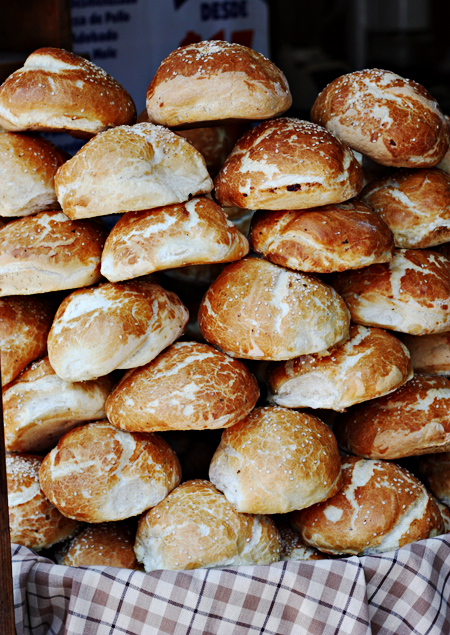
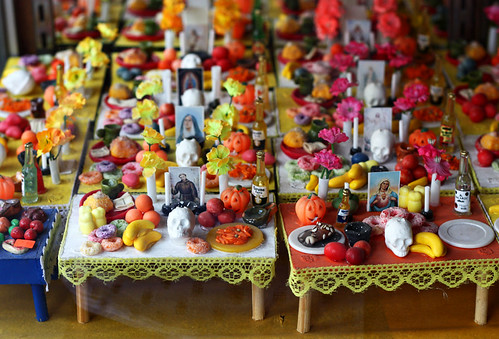
Day of the Dead altar models in Puebla - including miniature mole poblano, sprinkled with sesame seeds.


